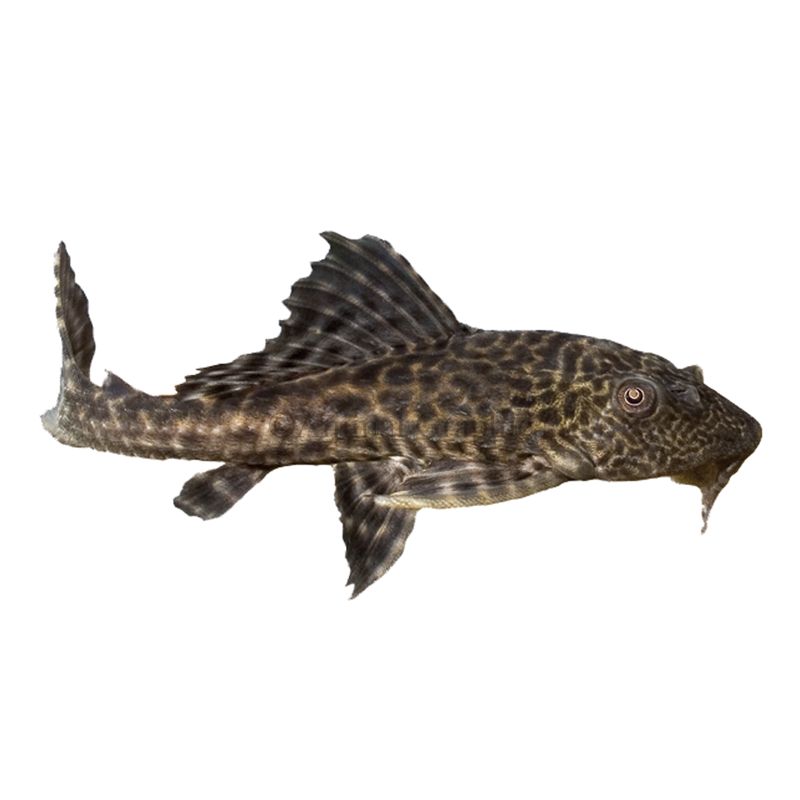The Armored Suckermouths
Plecostomus, or “plecos” as they are often called, belong to the Family Loricariidae, which is the largest family of catfish in the world. They are characterized by heavy armored plates on their bodies and sucker-shaped mouths. Scientists use a system of “L” or “LDA” numbers to identify plecostomus species, and at present, there are over 500 numbers with more being added each year. Some species, like the L046 Zebra and L177 Gold Nugget plecos, are brilliantly colored and command high prices in stores. Many plecostomus can breathe air due to modifications in their digestive tracts. For care and maintenance purposes, Farlowella and Otocinclus catfish can be included in this group.
Natural Habitat for a Plecostomus
Most Plecostomus species are native to South America, although a few can be found in Panama and Costa Rica. They occupy a wide range of habitats, although a number of species have very limited ranges and are only found in certain parts of specific rivers. Many plecos live in fast-moving shallow streams and rivers, while others inhabit acidic black water, and still others favor quiet, brackish estuaries. In high flow areas, they use their suckermouths to attach themselves to rocks and submerged trees to keep from being swept downstream.
Plecostomus Water Requirements
Loricariid catfish are typically found in soft water with a low pH in the wild, however, many species sold today are commercially raised and tolerate a much wider range of water chemistry. A pH between 7.0 and 8.0, alkalinity between 3° and 10° dKH (54 ppm to 180 ppm) and temperature between 74° and 80° F will suffice for most captive bred species. If the aquarium is kept in a room below 74°, use an Aqueon Aquarium Heater to maintain the proper temperature. Wild caught fish may require a temperature in the mid to upper 80’s, pH of 5.5 to 7.0, and alkalinity below 3° dKH (54 ppm), so it is best to research fish you are unfamiliar with before purchasing. Maintain good filtration and do a 10% water exchange every week or 25% every 2 weeks using an Aqueon Aquarium Water Changer or Siphon Vacuum Gravel Cleaner. Do not forget to treat tap water with Aqueon Water Conditioner before refilling your aquarium!

Pleco For Mac
Housing Requirements for Plecostomus
With so many species of suckermouth catfish to choose from, no matter what size aquarium or type of fish you own, there is one just right for you. For example, the common pleco, Hypostomus plecostomus, can grow to over 12” and will eventually need an aquarium of at least 75 gallons, while Otocinclus will be perfectly content in a 10-gallon tank. Plecostomus tend to be secretive, so caves, hollow logs and other size-appropriate hiding places should be available in the aquarium. Moderate to good circulation should be provided to simulate the fast-moving rivers many species inhabit in the wild. Decorate the tank with driftwood for refuge as well as a source of food.
Pleco is the ultimate Chinese learning companion - an integrated dictionary / document reader / flashcard system with fullscreen handwriting input and live OCR. Find Pleco Software software downloads at CNET Download.com, the most comprehensive source for safe, trusted, and spyware-free downloads on the Web.

Pleco For Mac Desktop


Plecostomus Behavior/Compatibility
Many suckermouth catfish are nocturnal and spend a good portion of the day hiding in a crevice or under an overhang. However, some will adapt to aquarium life and be more sociable during the day, especially at feeding time. Loricariids are compatible with most aquarium fish, although tank mates should be roughly the same size as they are. Large predatory fish may try to eat smaller pleco’s or Otocinclus, resulting in the catfish becoming lodged in the bigger fish’s throat. On the other hand, large plecos can be safely mixed with smaller fish as they will not usually try to eat them.
What Do Plecostomus Eat?
While plecostomus and other suckermouth catfish are typically sold as algae eaters, some species are carnivorous, feeding on carrion in the wild. Others feed almost exclusively on wood, so it is best to research the dietary needs of any species you buy. Aqueon Bottom Feeder Tablets, Shrimp Pellets, Tropical Granules and Algae Rounds can all be excellent foods for these catfish. Because of their nocturnal habits, many experienced hobbyists target feed their plecos once or twice a week with tablet or disc foods given at night. For best results, feed a variety of high-quality foods and rotate your fishes’ diet daily.
Plecostomus Breeding Level - Difficult
While not much is known about the spawning behavior of many rarer species, a fair number of suckermouth catfish have been bred in captivity. They typically spawn in caves, with the male caring for the eggs until they hatch. Fry, or recently hatched fish, are voracious and must be fed frequently on a high protein diet such as micro worms, brine shrimp nauplii, sinking tablets or disc-type foods. For intentional spawning, a separate aquarium should be set up and breeders should be fed live or frozen foods for several weeks to condition them.
